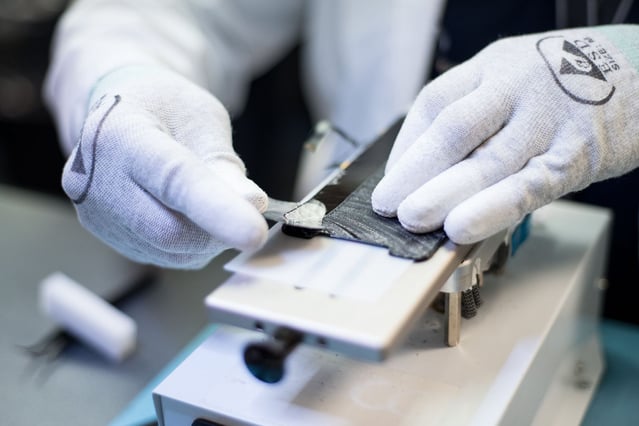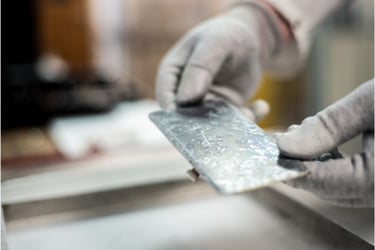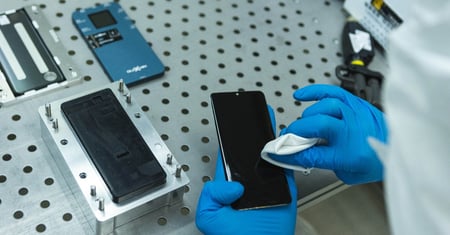Do you have a stock of used smartphones that have damaged screens? Have you processed these through insurance cases or received them from end-user trade-ins?
These broken devices are sitting on your balance sheets, losing value and taking up space when they could be repaired. The phone may be in good condition, but you know the screen is not to a high standard.
Ingram Micro Lifecycle has been offering our repair services for LCD (Liquid Crystal Display) and LED (Light Emitting Diode) smartphone screens to insurance and network operators for over a year.
We constantly seek innovations that drive more sustainable solutions while delivering cost savings to our customers. Through this, our smartphone screen repair combines various technologies to repair screens at various touchpoints of our lifecycle extension services.
Below, we'll explain what delamination is, what causes it, and how you can recover value on devices affected by damaged screens while helping your sustainability efforts.
What are the differences between LCD and LED screens?
LCD screens are made of layers including glass, liquid crystal, and a digitizer.
These are becoming a largely obsolete technology, typically found in older smartphones, as LED, OLED, and AMOLED technologies take preference.
These are:
- LED – Light Emitting Diode
- OLED – Organic Light Emitting Diode
- AMOLED – Active Matrix Organic Light Emitting Diode
With LED display types, an electric current passes through diodes to emit light, whereas an LCD requires a backlight. The display and colors on an OLED screen are of higher quality.
AMOLED screens are more energy efficient as a storage capacitor within a Thin Film Transistor (TFT) array controls each display pixel.
What is delamination?
Delamination is the separation of two or more surfaces in a composite material. It’s a process that not only happens to technology but also to other everyday objects such as credit cards, windscreens, and some kinds of wood.
You can experience this with LCD smartphone screens. Due to their layered nature, these can be subject to delamination.
How does delamination happen?

Repeated stresses and impacts of smartphones cause the separation of LCD layers. Regular use of tight-fitting cases, mounts, or other enclosures can lead to this, as well as frequent drops of the device onto hard surfaces. Micro-fractures that occur can separate the layers over time.
Oils and residues can also break the protective coating. These are typically transferred onto the phone screen from hands and fingers. Regular use of an electronic screen wipe will remove these.
Alternatively, extreme heat or cold can cause the subsurface adhesive to shrink and expand.
Poor quality or improper adhesives are more likely to experience this issue. You should always ensure LCD repairs are conducted professionally, to a high standard.
Causes of delamination include:
- Age/general wear and tear
- Low-quality adhesive
- Exposure to extreme temperatures
- Drops & repeated stress
What does delamination look like?
Delamination appears like an air bubble in the glass, raised edges, haziness, discoloration, or flakiness.
As this impacts the useability of the device, delamination classifies as a failure mode. This means that the component fails to perform to the expected standard, cosmetically and physically.
What about smashed screens?
Accidents happen. It’s an unavoidable fact of life, and as the volume of technology in circulation increases, so will the damage done.
It's a fairly common issue for LCD and LED screens to have the top glass layer on smartphones cracked or smashed.
In the US alone, an estimated 5,761 screens crack every hour – this is over 50 million every year. Over 50% of users in the UK have damaged their phones.
Smartphones with smashed screens are instantly a lower grade than those in good condition as the form and function are of a much lower standard. These, therefore, are lower value.
Often the touchscreen beneath the smashed glass layer is still functional, but the broken top layer will impact the functionality and be unsafe to use.
Rather than sending the whole device to a landfill, it’s much more sustainable to repair the broken parts.
Are DIY smartphone screen repair kits reliable?
It’s always best to get your smartphones repaired in a professional way to avoid doing more harm and reducing the value further.
DIY kits may seem like a cheap and tantalizing quick fix, but the potential risks outweigh any immediate benefits. For example, you could experience delamination if the kit is low quality or is fitted poorly.
You also may not have the necessary tools to successfully do it yourself.
Some online remedies for broken smartphone screens involve toothpaste and baking soda. These definitely won’t fix the problem of a smashed glass screen and may worsen the damage.
For any technical work, it’s best to invest a little more in getting repairs done professionally to ensure high-quality standards.
How can broken smartphone screens be sustainably repaired?
Typically, delaminated or cracked screens require a full-screen replacement or a repair.
Screen replacements can be expensive, but finding a partner who can conduct screen repairs is where you can save money and improve the sustainability of the device.
Screen repair replaces the damaged layers, rather than the whole screen, making this more cost-effective. By restoring the screen, the phone becomes fully functional with its value and condition restored to like new.
The device with a broken screen may have been headed for landfill, but as this has been avoided via repair, the device can go on to be re-loved, promoting a circular economy.
Improve your sustainability and recover value from damaged LCDs/LEDs
Ingram Micro Lifecycle offers a comprehensive LCD/LED screen repair service. We use the process of delamination to remove the top damaged layer of glass, salvaging the functioning layers underneath. The damaged glass is replaced, restoring the screen to a like-new condition.
Find out more about our smartphone screen repair service on our website or reach out to us today using our contact page or via the orange button below.
Recommended reading:








.jpg)




